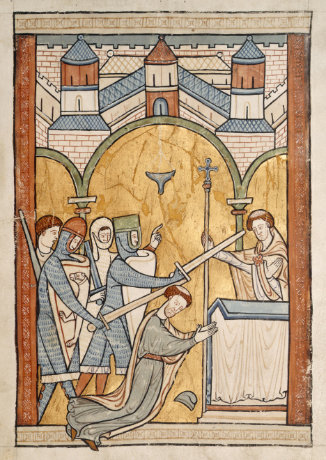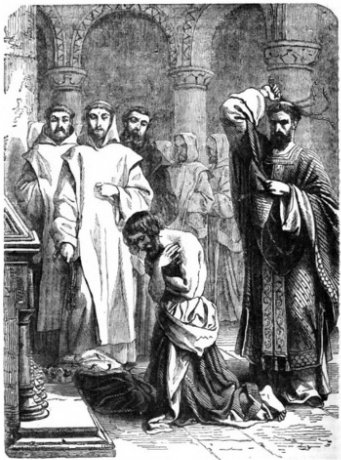Canterbury Cathedral Postcard
This printable postcard of Canterbury Cathedral is a fun writing project for kids - but of course you could also put it in the post if you wanted to! Print, cut out, fold and glue together.
&npsp;
Henry II (1154-1189) was the son of Matilda and Geoffrey of Anjou. He succeeded his cousin Stephen, bringing an end to the civil war that had been ravaging the country for nearly 20 years. He reigned for 30 peaceful years and had many great achievements - but is also remembered for the murder of Thomas Becket in Canterbury Cathedral.

When Henry died in 1189, aged 56, his oldest surviving son Richard took the throne (Richard I).
Henry and his wife Eleanor had five sons and three daughters – William, Henry, Richard, Matilda, Geoffrey, Eleanor, Joan and John. William died in infancy, and Henry and Geoffrey died in their twenties. Richard and John both went on to rule.
Eleven hundred and fifty-four,
Stephen the King, he was no more,
When he was definitely dead,
Henry the Second was King instead.
Henry was the son of Matilda and Geoffrey of Anjou. He inherited the throne at 21 on the death of his mother’s first cousin, Stephen. Henry’s accession ended nearly 20 years of civil war during which Stephen and Matilda had fought for the throne.
Expanding his lands
Henry went on to rule for 30 peaceful years. Two years before his accession, he had married Eleanor of Aquitaine, the former wife of the King of France (Louis VII). This meant Henry now ruled lands stretching from the Scottish border down to the Pyrenees. Later, in 1169, he asserted an English presence in Ireland as well.
Improving the legal system
Although he was small in stature, Henry was powerfully built. He was also a clever king. First, he set about dismantling castles that had been built illegally by barons during the civil war. He also began to change the judicial (law) system. He introduced a set of laws and proposed a fairer system of trial by jury (where a group of strangers listen to evidence and decide together whether someone is innocent or guilty). Previously, trials had been conducted by Church courts.
An unfortunate murder
Henry quarrelled with his great friend Thomas Becket, Archbishop of Canterbury, who thought the Church should keep control of the courts. In his frustration, Henry uttered the famous words ‘who will rid me of this turbulent priest?’ Unfortunately, four loyal knights took this as an instruction and murdered Becket in Canterbury Cathedral in 1170. Henry was appalled. He walked barefoot to Canterbury and allowed the monks there to whip him as punishment for what he had done.

An early depiction of Thomas Becket's murder in Canterbury Cathedral

Henry II doing penance at the tomb of Thomas Becket
Family problems
Sadly, Henry’s later years were marked by family rifts. His sons were keen for more power. Henry tried to resolve this by having his second (oldest surviving) son Henry crowned King of England in 1170, but he was reluctant to grant any real power to this position. The young Henry rebelled and was supported by his mother (and her ex-husband King Louis of France). It’s no surprise that Eleanor was later put under castle-arrest for rebelling against her husband.
Things settled down when Henry laid out some inheritance plans, although he still refused to grant his sons any real power. Young Henry died suddenly at 28 of dysentery (1183) and Geoffrey died at 27 after supposedly being trampled to death in a jousting tournament (1186). Each time the inheritances were redistributed, and John’s later inclusion took lands away from Richard, which caused another rift. The sons continued to plot against their father until his death, and swore allegiance to the new king of France (Philip II).
Henry died of a perforated ulcer at Chinon Castle, France, in 1189. He was buried at nearby Fontevrault Abbey and succeeded by his son Richard.
This printable postcard of Canterbury Cathedral is a fun writing project for kids - but of course you could also put it in the post if you wanted to! Print, cut out, fold and glue together.
Here's an illustrated poster of Canterbury Cathedral which might be useful as an insert or front page of a project. We've tried to keep the outline relatively simple for cutting out, too.
Colour in the picture of Canterbury Cathedral, and choose from lined or handwriting story paper to add some words beneath!
Here is a printable version of our summarised facts and short biography of Henry II, King of England. Download a 3-page pdf file below.
Here is a printable of a portrait of Henry II from the Google Art Project. It was done some time after his death so we can only guess that he looked liked this. He was a small man, but apparently quite strong.
This is the earliest known portrayal of the murder of Thomas Becket by four of Henry II's knights in Canterbury Cathedral, thought to have been done around 1200. It shows Becket praying at the altar of the Cathedral before he was killed.